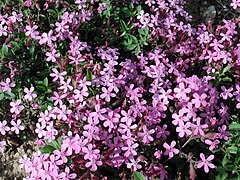Saponaria
| Saponaria subsp. var. | Soapwort | |||||||||||||||||||||||||||||||||||||||||||||||||||||||
|---|---|---|---|---|---|---|---|---|---|---|---|---|---|---|---|---|---|---|---|---|---|---|---|---|---|---|---|---|---|---|---|---|---|---|---|---|---|---|---|---|---|---|---|---|---|---|---|---|---|---|---|---|---|---|---|---|

|
|
| ||||||||||||||||||||||||||||||||||||||||||||||||||||||
| ||||||||||||||||||||||||||||||||||||||||||||||||||||||||
Saponaria, also known as soapworts, is a genus of about 20 species of perennial herbs in the Caryophyllaceae, native to southern Europe and southwest Asia. The most familiar species in Europe is the Common Soapwort (S. officinalis), locally simply known as "the Soapwort". They grow to a height of 10-60 cm, with opposite leaves 1-6 cm long. The flowers are produced in tight clusters on the stem, 4-25 mm diameter, with five white, yellow, pink, or pale purple petals.
The genus is closely related to Lychnis and Silene, being distinguished from these by having only two (not three or five) styles in the flower. The is used to make a soap, and also used in the food industry, especially in the making of halva.
| Standard Cyclopedia of Horticulture |
|---|
|
Saponaria (Latin, soap, the mucilaginous juice forming a lather with water). Caryophyllaceae. Soap-Wort. Hardy often coarse annual or perennial erect or decumbent herbs, used for borders and rockeries. Habit either annual and resembling that of gypsophila or perennial and similar to that of silene: lvs. flat: fls. in dichotomous cymes; calyx ovoid or oblong-tubular, 5-toothed, nerves obscure; petals 5, narrow-clawed, blade entire or emarginate, the base with scales or naked; stamens 10; ovary 1-celled: caps. ovoid or oblong, very rarely subglobose.—About 40 species, Eu., principally the Medit. region and extra-Trop. Asia. Saponarias are readily established in any soil and require but little care. S. ocymoides is an attractive plant for the rockery or for edging. Prop. by seed or division. S. japonica, Hort. John Saul, is botanically unknown.—S. pulvinaris, Boiss. (S. libanotica, Hort., S. Pumilio, Boiss.). Densely cespitose-pulvinate: sts. low, 3-7-fld.: lvs. small, linear, subcarinate: infl. hirsute-villous; fls. bright rose.—S. Sundermannii, Hort., closely resembles S. bellidifolia, but has rather larger fls. and more of them. June.—S. Weinmannii, Hort., is closely allied to S. caespitosa, possibly only a form of it, but has paler purple fls. and a shorter calyx. Its habit is very compact and it is only 2-3 in. high. CH
|
Cultivation
Soapworts are cultivated for their attractive flowers; they grow freely in any soil and under most conditions.
Propagation
Pests and diseases
Species
About 20 species, including:
Saponaria bellidifolia
Saponaria caespitosa
Saponaria calabrica
Saponaria lutea
Saponaria ocymoides: Rock Soapwort
Saponaria officinalis
Saponaria pumila
Saponaria sicula
Gallery
References
- Standard Cyclopedia of Horticulture, by L. H. Bailey, MacMillan Co., 1963
External links
- w:Saponaria. Some of the material on this page may be from Wikipedia, under the Creative Commons license.
- Saponaria QR Code (Size 50, 100, 200, 500)
